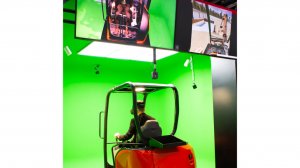Virtual training key to cost-effective skills development



MUHAMMAD ALI Companies can achieve additional cost savings through integrating virtual reality training
VIRTUAL ERA Trainees can develop skills in a simulated environment that mimics real-life conditions while reducing risks
The mining industry is increasingly turning to virtual reality (VR) training to equip employees with essential skills in a simulated environment that mimics real-life conditions while reducing risks, reports consultancy firm World Wide Industrial and Systems Engineers MD Muhammad Ali.
VR training simulates physical environments, such as underground or at height, providing a realistic experience that helps workers understand various safety hazards and operational tasks more effectively.
It forms part of a broader virtual training programme, which also includes Web-based classroom platforms.
While traditional classroom training with a facilitator remains a preferred method, Ali says many organisations within the mining industry are adopting blended learning approaches, which entail various training methods.
VR modules are developed into immersive three-dimensional experiences using software that replicates different working conditions. By simulating physical environments, VR training enables trainees to practice the skills they are learning, which is crucial for measuring the effectiveness of a training programme and aligning theory with real-world experiences, he elaborates.
“This has been effective in reducing the cost of training and optimising the delegate’s ability to perform, as results have shown a decline in safety incidents and [an increase in] productivity after VR training,” says Ali.
With safety being a focal point in the mining industry, he highlights that VR training can assist in familiarising trainees with mining processes such as grinding, crushing and the handling of explosives.
Ali explains that VR training can be implemented for various mining jobs, including working at height, working with hazardous substances and materials, operating machinery and equipment, along with using robotics, process automation and in terms of improving general health and safety within a mining setting.
Further, VR training offers versatility as custom VR courses can be developed to meet the requirements of different operational tasks.
Despite the high costs associated with developing a VR training programme, Ali acknowledges that the ongoing operational expenditure of a VR programme, once developed, is low. This longer-term cost efficiency can potentially enhance profitability within the mining sector, he enthuses.
In addition, through using VR training, Ali says companies can achieve additional cost savings as they can reduce the number of onsite facilitators, in addition to savings gained through the ability to deploy VR remotely and with the ability to operate such a system offline.
Hurdles Ahead
While interest in VR training is gaining momentum in various mining industries globally, Ali notes that further rollout of the technology still faces regulatory hurdles, as a result of regulatory bodies still coming to terms with trying to understand the value and weighing up the risks of VR training to determine its effectiveness.
He points out that regulatory entities, such as the sector education and training authorities and the South African Qualifications Authority, are yet to define relevant VR curricula and develop appropriate accreditation standards thereto.
Ali also points out that there remains some reluctance to implement VR training from industry stakeholders owing to the lack of a comprehensive understanding of what VR training entails and the benefits it offers.
To address this, he encourages decision-makers and technology officers to explore and experience VR first-hand to overcome any reservations about adopting this technology.
Comments
Press Office
Announcements
What's On
Subscribe to improve your user experience...
Option 1 (equivalent of R125 a month):
Receive a weekly copy of Creamer Media's Engineering News & Mining Weekly magazine
(print copy for those in South Africa and e-magazine for those outside of South Africa)
Receive daily email newsletters
Access to full search results
Access archive of magazine back copies
Access to Projects in Progress
Access to ONE Research Report of your choice in PDF format
Option 2 (equivalent of R375 a month):
All benefits from Option 1
PLUS
Access to Creamer Media's Research Channel Africa for ALL Research Reports, in PDF format, on various industrial and mining sectors
including Electricity; Water; Energy Transition; Hydrogen; Roads, Rail and Ports; Coal; Gold; Platinum; Battery Metals; etc.
Already a subscriber?
Forgotten your password?
Receive weekly copy of Creamer Media's Engineering News & Mining Weekly magazine (print copy for those in South Africa and e-magazine for those outside of South Africa)
➕
Recieve daily email newsletters
➕
Access to full search results
➕
Access archive of magazine back copies
➕
Access to Projects in Progress
➕
Access to ONE Research Report of your choice in PDF format
RESEARCH CHANNEL AFRICA
R4500 (equivalent of R375 a month)
SUBSCRIBEAll benefits from Option 1
➕
Access to Creamer Media's Research Channel Africa for ALL Research Reports on various industrial and mining sectors, in PDF format, including on:
Electricity
➕
Water
➕
Energy Transition
➕
Hydrogen
➕
Roads, Rail and Ports
➕
Coal
➕
Gold
➕
Platinum
➕
Battery Metals
➕
etc.
Receive all benefits from Option 1 or Option 2 delivered to numerous people at your company
➕
Multiple User names and Passwords for simultaneous log-ins
➕
Intranet integration access to all in your organisation



















